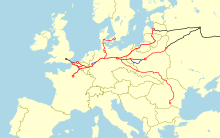Nord Express
You can help expand this article with text translated from the corresponding article in Dutch. (February 2013) Click [show] for important translation instructions.
|

The Nord Express (Northern Express) was a
Introduced in 1896 by the
caused the end to this famous train.Although the Nord Express has received significantly less attention than the Orient Express, it is one of the CIWL's best-known luxury trains and has been featured in a number of artistic works.
History
Background

In 1874, the
Before World War I

On 9 May 1896, the Nord Express departed for the first time from the French to the Russian capital. This train service enabled people to travel across Europe in what was, by the standards of the time, a very fast and comfortable manner. For the operation of the Nord Express, the CIWL had to close contracts and timetable agreements with fourteen railway administrations, including nine Prussian administrations, as well as the ferry service across the English Channel between Dover and Ostend.
The train left
Interwar period

After World War I and the Russian Revolution the train's route was shortened to Warsaw and Riga instead of Saint Petersburg. Riga joined the connection in 1923, with a separate Riga–Moscow line introduced as well.
Post-War Period
After
The emergence of air travel and high-speed rail caused the end to this famous train. In 2007 it was shortened further and such that it ran between Paris and Hamburg, taking 10.5 hours.
In the arts
The Nord Express has received significantly less attention than the Orient Express. Nevertheless, it is one of the CIWL's best-known luxury trains and has been featured in a number of novels and films:
- Inspector Jules Maigretwho would later appear in more than a hundred stories by Simenon and who has become a legendary figure in the annals of detective fiction.
- Vladimir Nabokov describes in the seventh chapter of Speak, Memory how he traveled on the Nord Express from Saint Petersburg to France for a holiday in 1906.
- Alfred Hitchcock's movie Strangers on a Train (1951),[2] was translated to French as "L'inconnu du Nord-Express" (The unknown man in the Nord-Express).
- The animated 20th Century Fox movie, Anastasia(1997) mentioned that the train was traveling from Saint Petersburg to Paris, which was most likely referring to the Nord Express.
- The final conflict of The Silver Skates revolves around gaining passage to Paris on the Nord Express.
References
Citations
- ^ For a short history of the company, see Behrend, Georges, "The History of the Wagons-Lit, 1876-1955", Modern Transport Publishing Co., 1959.
- ^ "Strangers on a Train (1951)". Internet Movie Database. Retrieved 2008-03-05.
Bibliography
- Behrend, George (1959). The History of the Wagons-Lit, 1875-1955. OCLC 4535323.
- Mühl, Albert (1991). Internationale Luxuszüge : Die grossen europäischen Expresszüge durch Deutschland, Österreich und die Schweiz [International Luxury Trains : The great European express trains through Germany, Austria and Switzerland] (in German). ISBN 3-88255-673-0.
See also
- Famous trains
